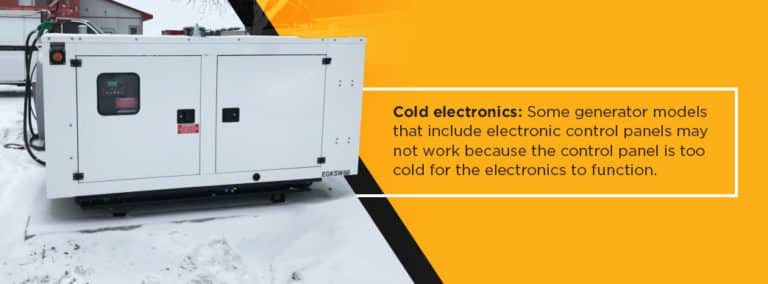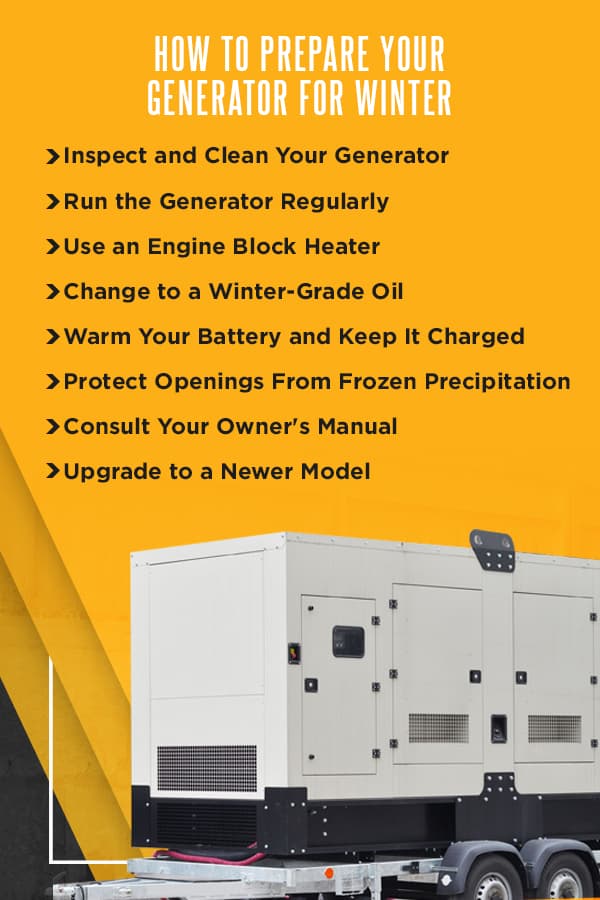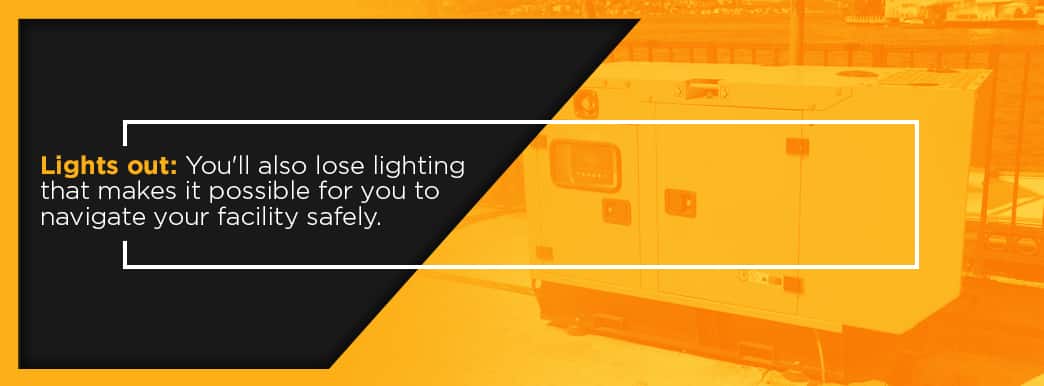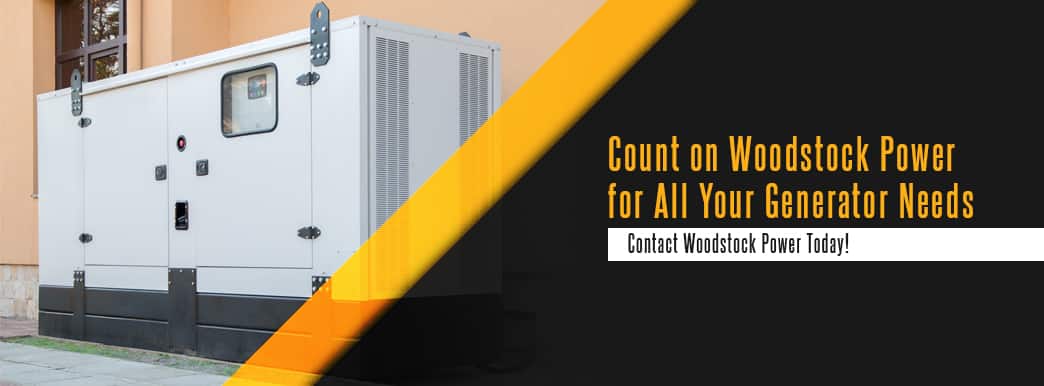How to Prepare Your Commercial Backup Generator for Winter

Power outages can easily occur during the winter in states that experience sub-freezing temperatures. One issue is winter storms, whose wind & snow can take down power lines, quickly stripping your business of power. Another possibility with winter storms is when combined with freezing rain, high-speed wind, and snow can cause power lines to freeze completely, resulting in power loss. Even when you aren’t dealing with storms, cold temperatures could also contribute to a power outage. As higher demand and cold temperatures both place more stress on the electric system, it can fail. This issue is particularly problematic because much of our country’s electric infrastructure is operating well beyond its intended lifespan.
A backup generator can be the thing that stands between you and a power outage during the winter, but what if your plan B fails? Your generator can also suffer from winter weather. However, you can take steps to prepare your generator for winter, so it’s ready to help you maintain your productivity and comfort when you need it.
Why Your Commercial Generator May Not Start in the Winter

There are a few reasons your generator may have trouble starting during winter months. The exact cause may depend on your generator’s age, its parts and the type of fuel you use. It will also depend on the weather conditions it experiences. When we talk about winter conditions, we’re talking about cold, including sub-freezing, temperatures and frozen precipitation. So, how can cold temperatures and snow or ice make it more difficult for your backup generator to start?
Here are a few of the main reasons your generator won’t start in winter weather.
- Cold oil: Cold temperatures will change the viscosity of your oil. Cold oil will be thicker than usual, making it harder for it to flow as it should. Cold oil could also trigger the generator’s low oil sensor, which will prevent the generator from running for long periods of time or can even prevent the generator from starting at all.
- Cold battery: Cold batteries have less power than warm ones, even when fully charged, so especially if your battery only has a partial charge, it may be the main source of the problem. A battery that has become weak may not be able to power your generator’s electric starter.
- Cold electronics: Some generator models that include electronic control panels may not work because the control panel is too cold for the electronics to function.
- Air blockage: When snow, sleet or ice builds up in the air intake ports or the exhaust, you may not have the airflow you need for your generator to function properly.
- Exposure: Generators that are often placed outside of the facility can often be subject to sub-zero, freezing temperatures that can negatively impact the generator from functioning properly. For example, natural gas generators are estimated begin to lose the ability to run and operate at their assigned power rating when temperatures drop -20 degrees below zero.
- Wet Stacking: “Wet stacking” refers to unburned fuel mixed with carbon soot that builds up in the exhaust pipes. Running your commercial generator in cold weather can prevent it from reaching the proper operating temperature and can cause a buildup of fuel. Learn more about wet stacking from Woodstock Power.
How to Prepare Your Generator for Winter
Let’s talk about what you can do now, as the temperature outside begins to fall, so your generator is ready to stand up to harsh winter weather. By following these eight tips for generator winter preparation, you can have greater confidence that your generator will be ready to provide backup power when you need it.

1. Inspect and Clean Your Generator
It’s always a good idea to periodically inspect your generator. In the fall, leaves and twigs can easily end up in your generator’s air vents if it’s outside. So, when the weather turns colder, check to be sure there is no debris blocking any of the air vents. You should also make sure the surrounding area is clear and that there are no loose wires or parts and no signs of corrosion.
Clean out any debris you find and address any concerns regarding compromised parts. You can clean the engine, as well, but make sure you use an air supply since this method of cleaning will gently blow away dirt and dust. Using a power washer or another harsh cleaning method could damage your generator.
Visually inspecting your generator, as well as checking all fluid levels, connections and hoses is a great way to conduct a preliminary checkup before proceeding to a load bank testing, service, and maintenance phase.
2. Run the Generator Regularly
It’s also a good idea to run your generator regularly. Letting your generator run regularly is critical during winter months. When the generator runs, the moving parts become lubricated, and it maintains the seals in the generator. If you don’t exercise your backup generator periodically, it may not start up when you need it to.
Running your generator once a week also allows you to conduct a quick visual inspection, as we discussed above, and can tip you off early to any potential issues the generator is experiencing. If your generator sits inactive for long periods, parts could go bad without you realizing it until you’re counting on your generator to provide backup power and find out it’s not working.
One of the most important reasons to run diesel generators regularly is to prevent an occurrence known as wet stacking. When generators are regularly run only for periods of time at less than 60% of its rated output, carbon can build up within the exhaust and can permanently damage the engine.
Natural gas generators require more regularly scheduled maintenance than their diesel counterparts. When you regularly run the generator for testing, service, and maintenance, it can help to reveal problems or potential problems that may need to be addressed with the generator. If there is a cracked or leaking hose, for example, the hose can be replaced early on to ensure that the generator is ready to go when needed.
Generator load bank tests are a great way to test the output of a generator to see if it is reaching its assigned output rating. These load bank tests can be a great indicator for the overall health of the generator and can help identify any additional items that need to be addressed.
3. Use an Engine Block Heater
Another thing you can check weekly is the engine block heater. If you don’t already have one of these devices, you should install one before winter hits. An engine block heater, also called a water jacket heater or an engine pre-heater, can prevent dangerous cold starts by keeping the engine oil warm when the generator is idle.
According to the National Fire Protection Agency regulation 110, all sources of emergency backup power should be able to reach operating conditions within just 10 seconds of starting. The engine coolant should remain between 100 and 120 degrees Fahrenheit.
Some people make the mistake of turning their engine block heater off to save on their utility bills, but you should never do this, particularly not when winter is approaching. An engine block heater combats the issues that cold temperatures present for starting generators, so they can be your best friend when you need backup power in the winter. You may also want to consider installing a coolant heater, air inlet heater and a control panel heater if your generator faces freezing temperatures.
4. Change to a Winter-Grade Oil
A block heater is always helpful, but if you live in an area with especially cold winter temperatures, another action you can consider taking to prepare your generator is to switch to a winter-grade oil. As we discussed, lower temperatures cause the oil in your generator to become thicker, almost gel-like, making it more difficult for the engine to start.
You can lessen the friction and make it easier for your generator to start by using a thinner oil designed for winter use. Switching to a thinner oil is an especially good idea if you expect you may operate your backup generator frequently during the winter. You can switch back to your typical oil once temperatures begin to warm back up in the spring.
5. Warm Your Battery and Keep It Charged
If your generator uses a lead-acid battery, it’s helpful to know the cold can adversely affect it. Exposure to below-freezing temperatures can even reduce it to functioning at less than half its capacity. One solution is to make sure your battery stays charged. You may even want to switch to a larger battery if needed.
The other way to prevent issues is to keep your battery warm, so outdoor temperatures won’t affect it. You can do this with a thermostatically controlled warming blanket. Plug the blanket into the main source of power or whatever source of power you are using for your engine block heater so the heater can continually protect your battery during the winter.
6. Protect Openings From Frozen Precipitation
Air intake ports can allow more than just air to get into your generator. Precipitation, such as ice, snow or sleet, can also make it into air intake ports and can obstruct airflow. Another part of your backup generator that can allow precipitation in is the exhaust. Having a cover over your generator can help protect it from vertical precipitation.
To protect air intake ports from horizontal-blowing precipitation, install snow hoods or, better yet, louvers. These angled slats allow air to pass through but can effectively block snow, ice and sleet from getting in and blocking up your airflow. You can select fixed options or adjustable ones so you can change the angle as needed. Adjustable louvers can be manual or motorized.
If your generator is installed outside of your facility and has a weatherproof enclosure, be sure to inspect the enclosure and check for any oxidation or rust spots that have allowed the generator to be exposed to the open air. Over time, depending on location and elemental exposure, generator enclosures can deteriorate over time and can become structurally unstable and can enable leaks or gaps in the enclosure.
7. Consult Your Owner’s Manual
We could add this piece of advice to just about any problem you may experience with your generator. Since every brand and model is different, you should always go straight to the source to find out what the manufacturer has to say about preparing your generator for winter and how to start the generator in winter. Checking the manual is especially vital when you want to make sure you don’t do anything to void the warranty.
If you bought your generator used and it did not come with a manual, you will likely be able to find it online. Use the exact model name and number to search for a digital copy of the owner’s manual. If you can’t find it, write the manufacturer to request a copy. Carefully follow your manual’s instructions for winter preparation and maintenance so your generator can keep running at its best, even in harsh conditions.
8. Upgrade to a Newer Model
If you’re having a great deal of trouble operating your generator in the winter and you’ve followed all the other guidelines for preparations, it may be time to upgrade to a new generator. Older models that include digital control panels, for instance, can be completely unusable in the winter because the cold temperatures cause the electronics to fail. You may be able to combat this issue with a heater for your control panel.
Make sure you test your generator out as soon as temperatures drop so you can see whether it will be dependable during the winter or whether you may need to replace it. An industry professional can help you determine the best generator for your needs. You may be able to rent a generator during the winter to see how it does before purchasing that same model. You can also buy a quality used generator if the cost is a concern.
Woodstock Power specializes in saving businesses huge percentages off of the typical cost to replace a generator. Don’t rely on a faulty generator going into the winter, since the extra stress of cold and frozen precipitation can be enough to render it useless when you need it most.
What Can Go Wrong If You Don’t Properly Prepare Your Generator for Winter?
If you don’t take the time to properly prepare your generator for winter, you shouldn’t assume it will work flawlessly when you suddenly need to rely on it for backup power. You’ll likely find your generator doesn’t fire up easily, and you need to try to address the problem yourself or call out a service expert so you can eventually start it.

In the meantime, you won’t have power to your business. The consequences of this will differ from industry to industry and company to company, but it could easily mean a major disruption in your business. Here are several consequences you could suffer if your generator doesn’t start up when you need it.
- Generator failure: Quite simply put, your generator could fail to work when needed.
- Unplanned downtime: Since a power outage will turn off computers, machinery and many other things you depend on to remain productive, you’ll face unplanned downtime, an issue that is especially expensive for manufacturers.
- Loss of heat: If you can’t provide fundamental needs like heat for your workers, you’ll have to send them home. Even if temperatures are not unsafe, workers may still have trouble focusing when they’re uncomfortable.
- Lights out: You’ll also lose lighting that makes it possible for you to navigate your facility safely. If your business has lots of windows, and it’s light outside, you may be able to muddle through, but many industrial facilities will become unsafe spaces without proper lighting.
- Digital systems down: Computers, hard drives and any other digital systems that rely on electric power will shut off in a power outage. You and your employees won’t have access to files and applications you need to remain productive.
- Spoiled product: If you work with pharmaceuticals or food and beverages, another major consequence is the loss of refrigeration and freezers. When it gets too warm, products could thaw or exceed the temperature needed to ensure their freshness or potency.
- Business closure: When your business can’t function due to a lack of heat, light and other critical capabilities, you’ll have to close your doors, which can result in significant financial losses.
Unfortunately, power outages are all too common during the winter, since winter storms and heavy snow can take down power lines easily. That’s why it’s so critical to be prepared. You’ve taken the first critical step by having a commercial backup generator installed. Now, you have to make sure it works when you need it. By taking steps to prepare your generator for winter, you can avoid the severe consequences that come with a power outage at your business.
Count on Woodstock Power for All Your Generator Needs
Here at Woodstock Power, we’ve built a reputation as a trusted source for generators to fit any company’s needs. We pay attention to each of our customers’ unique power needs, so we can set you up with the best possible solution. We offer used and rental generators in a variety of types and sizes, and we can provide a wide range of solutions for companies all over the nation.
If it’s time to upgrade your backup power system, contact Woodstock Power today. Winter weather is around the corner, so you want to be ready with a heavy-duty commercial generator that will run in even the harshest conditions.


